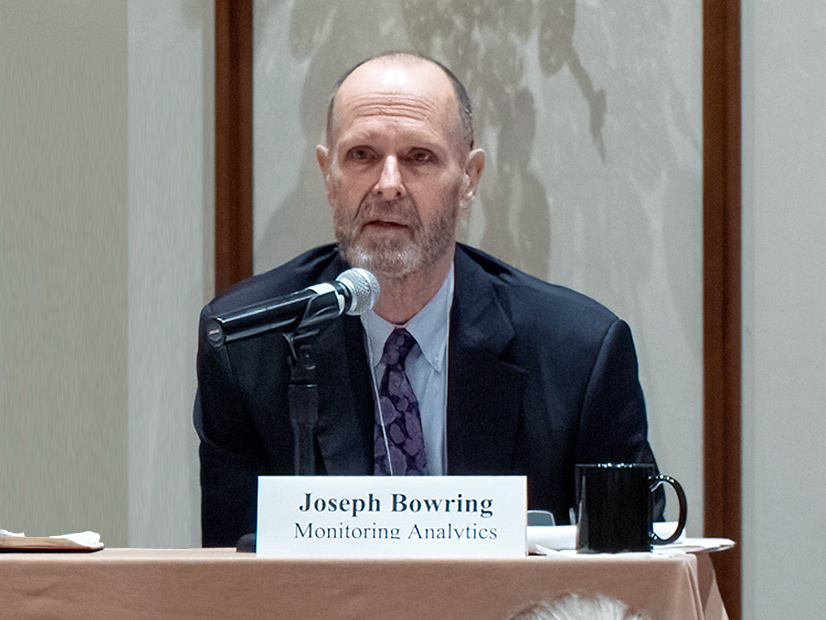PJM and the Independent Market Monitor presented the Deactivation Enhancement Senior Task Force (DESTF) with two proposals increasing the notification generators seeking deactivation must provide PJM and standardizing compensation for those that agree to continue operating beyond their desired retirement date.
Speaking at the April 15 task force meeting, Monitor Joseph Bowring said that when requesting payment for reliability-must-run (RMR) contracts, generators include a combination of sunk costs and estimated costs in an artificial regulated utility rate case framework that results in significant overcompensation. RMR contracts are needed for generators that want to retire but which the RTO has determined must remain online to maintain reliability for a period that can extend to five years or longer.
Bowring argued the current practice is inefficient and creates uncertainty for all parties as settlement discussions last for years. He said the Monitor’s first principle is that compensation rules should be clear and unambiguous. Under the Monitor’s proposal, generators would be paid the actual costs the generation owner would incur in keeping the unit online, net of any revenues the unit received through PJM’s markets, plus an incentive. There would be a verification process for all such costs.
The proposal would allow generators to include in their RMR compensation: actual maintenance costs; short-run marginal costs, such as fuel and consumables; and new investments needed for the generator to remain available, along with an incentive payment calculated as a percent of incurred costs. Costs related to general overhead, artificial utility rate case elements, and previously incurred capital and inventory costs would not be included.
Generators seeking retirement would be required to notify PJM of their intent six to 12 months in advance of the capacity auction for the delivery year in which the unit would go offline, with the aim of giving other market participants time to offer resources that could resolve reliability needs prompted by the deactivation.
Resources operating on an RMR contract would be dispatched only when required for reliability and would not be included when calculating the capacity emergency transfer objective and capacity emergency transfer limit values, which are inputs used to determine the amount of capacity PJM aims to procure through Base Residual Auctions (BRAs). Market sellers operating on an RMR contract would not receive capacity performance (CP) bonus payments, nor would they be subject to underperformance penalties during emergency conditions. Bowring has argued that including RMR units in the capacity market and resource stack suppresses prices that could incentivize new generation.
Bowring also argued PJM should use the same reliability criteria in defining the demand in the capacity market as it uses to define the need for an RMR contract. Currently, a unit could fail to clear in the capacity market but be deemed necessary for reliability and thus eligible for an RMR contract.
Christian McDewell, of the Pennsylvania Public Utilities Commission, said FERC rejected limiting bonus payments to capacity resources and excluding energy-only resources when it rejected changes to the CP design PJM proposed following the critical issue fast path process (ER24-98). (See FERC Rejects Changes to PJM Capacity Performance Penalties.)
Bowring said consumers shouldn’t have to pick up all the costs of keeping a fuel production facility operational in addition to the marginal costs to keep the generator online. He added that potential interactions between RMR compensation and fuel procurement warrant further stakeholder consideration.
Responding to stakeholder questions of whether PJM should be granted the ability to mandate RMR contracts, Bowring said he believes that would be unnecessary if the RMR design ensures contracts provide appropriate revenues for generators contemplating deactivation. Bowring stated that compensation should be the same in both cases and cover all actual costs of being an RMR unit plus an incentive.
PJM Proposal Centers on Notification Deadlines
The PJM package focuses more heavily on the notification requirements for deactivation and leaves compensation changes for further stakeholder deliberation. The proposal groups deactivation requests into three classifications based on the energy that would be brought offline: Requests larger than 300 MW would be required to provide notification three years in advance of their desired deactivation date; units between 100 MW and 300 MW would require one year’s notice; and those under 100 MW would follow the status quo 90-day period.
The notification period could be curtailed under PJM’s proposal if the capacity auction for the delivery year in which the resource would go offline is after the notification deadline. In such cases, generators could submit a deactivation request before the deadline for them to offer into the BRA.
Generators also would be permitted to retire earlier if PJM finds no reliability violations from by taking the unit out of service.



